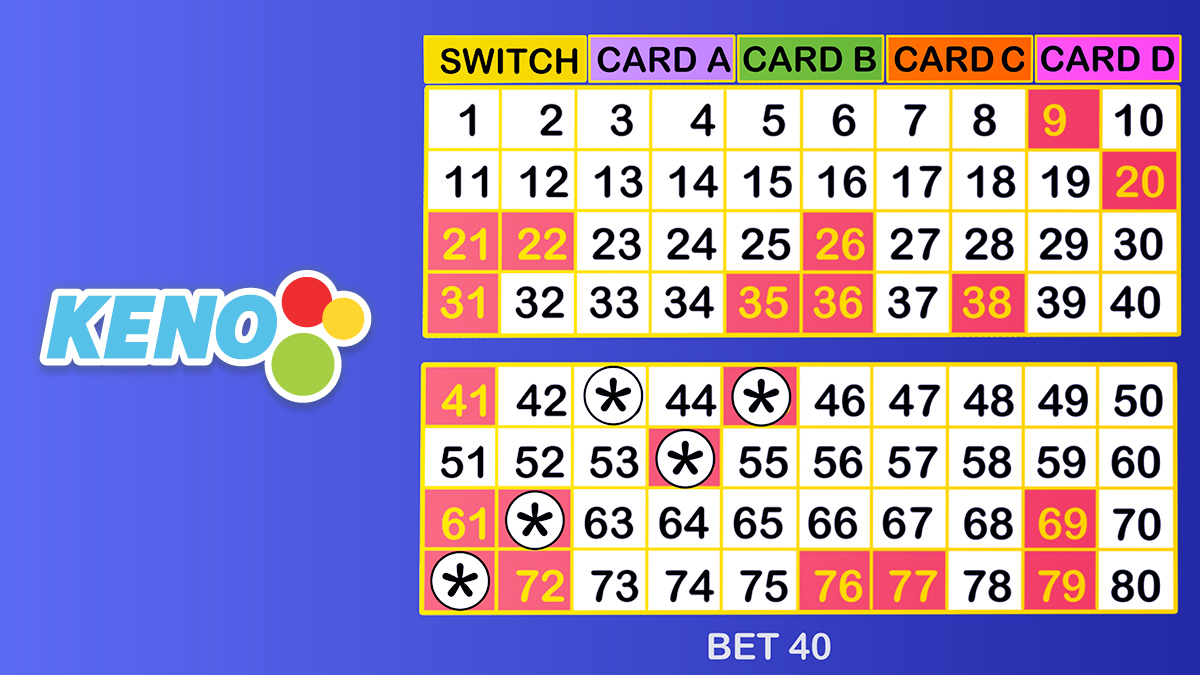How many spots are on a standard keno board?
This is the kind of question you’ll see regularly when you write about casino games.
Most of the blog posts in the casino niche focus on the games that get the most action, so you’ll find more blog posts about blackjack and slot machines than all the other games combined.
But keno offers some interesting insights into how casino gambling works, so I want to answer the question how many numbers are on a keno board along with several other questions.
How Keno Works
Keno is not a game of skill. All casino games involve chance, but some of them have elements of skill. Blackjack is an example of a casino game where you make decisions that influence your outcomes.
Keno is an example of a game that’s entirely random.
Most Americans have participated in a state lottery at some point. If that describes you, you’ll have no trouble understanding keno.
Keno is better than the lottery in a few ways, though. For one thing, you have more ways to play and to win at keno.
But, in both keno and the lottery, the really big prizes are so unlikely to be won as to be practically impossible.
Keno is the slowest game in the keno. At most games, you’re going to make 50 or 60 bets per hour. In some casino games, you might make as many as 200 or 600 bets per hour.
In keno, though, you’re looking at 5 to 15 bets per hour at the most.
Keno is also one of the cheapest games in the casino. You can play for $1 or $2. Most of the other games in the casino have a minimum bet of $5 or more.
How to Play Keno in a Casino
Most casino games have specific areas where you play. Keno is an exception – you can play from basically anywhere in the casino. You can even see keno results on the TV in your hotel room at most casinos.
The keno lounge is the main place for the game, but most casinos also make keno tickets available in the restaurants. The numbers are posted throughout the casino on keno boards.
The keno even has staff who will come by and take your money and your keno ticket while you’re eating. These people are called “keno runners.”
How Many Numbers Are on a Keno Board?
There are 80 numbers on a keno board 1, 2, 3, 4, etc., all the way to 80.
A keno ticket is called a blank, and it also has 80 numbers on it. A blank has 2 sections – a top section (numbered 1 through 40) and a bottom section (numbered 41-80).
Gameplay in keno is simpler than you could probably imagine. The keno computer chooses 20 numbers from 1 to 80. When you buy a keno ticket, you choose some numbers (called “spots”) and hope they match the numbers that are randomly drawn.
Most keno players just play “straight tickets.” You choose between 1 and 15 numbers. Then you get a payoff based on the pay table listed in the keno brochure at the casino when you hit your number(s).
The more numbers you play, the more numbers you must “catch” to win money.
But you don’t have to catch all the numbers to win. If you play the lottery, you’re probably already familiar with how that works.
On a 6-spot – a ticket where you chose 6 numbers – you usually need to match 3 numbers to win a prize. If you match 4, 5, or 6 numbers, you get a correspondingly bigger prize amount.
On a 15-spot – a ticket where you chose 15 numbers, natch – you usually need to math 6 numbers to win a prize. The more numbers you match, the more you win.
Of course, you have lots of other ways to play tickets with cool names like combination tickets, king tickets, and way tickets.
But they’re not really that different.
They just give you a way to play multiple games on a single ticket.
The house edge is just as high with these other kinds of tickets.
The House Edge in Keno
The mathematical advantage that the casino enjoys in keno is higher than any other game. Even the best keno games have a house edge of 25%, but many casinos have a house edge of 40% or more on their keno games. Casinos claim that keno is a high-overhead game, and that’s why they have such a big edge – to pay for that.
How does the house edge work in a casino game like keno?
It’s a function of how likely you are to win and how much you get paid off when you do win.
Both these factors can be explained in odds terms. The odds of winning might be 2 to 1, which means you have 2 ways to lose for every single way to win. In other words, you’ll win 1 out of 3 times on average.
If that game pays off at even money, or 1 to 1 odds, it’s easy to see how the casino has a mathematical edge.
On average, for every 3 bets you make, you’ll lose 1 bet twice and a single bet once, and your net loss will be 1 bet over 3 bets. That’s a house edge of 33.33%.
If the bet paid off at 2 to 1, you’d break even, and the house would have an edge of 0%.
More About Keno Tickets
Filling out a keno ticket is easier than you could imagine, but it does have a couple of things to consider.
The first thing you do is choose which numbers you want to play. You just put an X over the numbers you’re playing.
On the top right of the keno ticket, you can decide how many drawings you want to participate in with these numbers. You also write down how much you want to bet on each game and what the total ticket costs.
A reasonable pay table for a 6-spot keno ticket might look like this:
- Catch 3, win even money
- Catch 4, win 5 for 1
- Catch 5, win 75 for 1
- Catch 6, win 2000 for 1
It’s important to understand that the payout odds say “for” on purpose. There’s a difference between getting paid off 5 to 1 and getting paid off at 5 for 1.
Keno, like slot machines ands video poker, trade your bet for your winnings. You get $5 back for your $1 in that scenario – the casino keeps your $1 that you used to buy the ticket.
If you’re playing blackjack, though, you get your wager back along with your winnings. This is true of all the table games you play in the casino, too.
Also, the house edge for the pay table I used as an example in this section is 30%.
The game sounds good because a $2000 win on a $1 bet is a big deal, but the probability of winning that is much lower than 2000 to 1.
Combination Tickets, King Tickets, and Way Tickets
I mentioned earlier that the straight ticket in keno is only one option that you have. You can also use the following ticket variations:
- Combination tickets
- King tickets
- Way tickets
The easiest to understand of these is the way ticket. That’s a ticket where you want to mark multiple sets of numbers to bet on. You might have 3 groups of numbers with 3 numbers in each group, for example.
You would put an X on each of those numbers, but you would then circle each of the 3 groups. When you mark how many games you’re playing, you’d write 3/3.
You’re betting on 3 ways to make a 3-spot.
A combination ticket combines the groups on your way tickets. For example, you could place 7 bets on a single ticket by writing 3/6 and 1/9 on the ticket. This would give you every possible combination of those numbers, including a 9-spot.
A king ticket uses a single number combined with other groupings. It’s like having a way ticket, but one of the groups of numbers consists of a single number – the king number.
And that’s just for starters.
You can also play top or bottom – either the top 40 numbers or bottom 40 numbers. If 13 of the numbers drawn match the one you chose, you get a payoff.
You can also play left or right, which works the same way but covers the numbers differently.
You can even play edges, which means you’re marking all the numbers surrounding the edge of the ticket.
Conclusion
How many numbers are on a real money keno board?
80
But that’s only the beginning of keno wisdom. Understanding the game requires you to know how to choose numbers between 1 and 80 in various ways.
Start with a straight ticket before getting into some of the more complicated variations.
Also, don’t put a lot of money on keno. The house edge is really high when compared to other casino games.
Michael Stevens
Michael Stevens has been researching and writing topics involving the gambling industry for well over a decade now and is considered an expert on all things casino and sports betting. Michael has been writing for GamblingSites.org since early 2016. …



